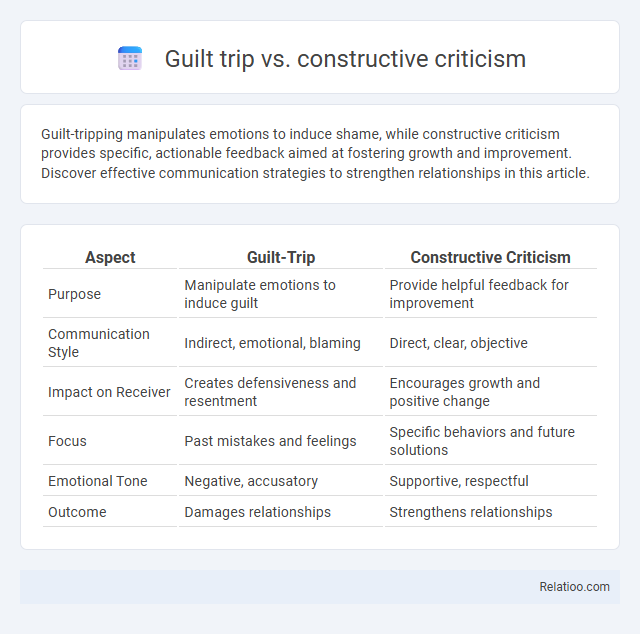Guilt-tripping manipulates emotions to induce shame, while constructive criticism provides specific, actionable feedback aimed at fostering growth and improvement. Discover effective communication strategies to strengthen relationships in this article.
Table of Comparison
| Aspect | Guilt-Trip | Constructive Criticism |
|---|---|---|
| Purpose | Manipulate emotions to induce guilt | Provide helpful feedback for improvement |
| Communication Style | Indirect, emotional, blaming | Direct, clear, objective |
| Impact on Receiver | Creates defensiveness and resentment | Encourages growth and positive change |
| Focus | Past mistakes and feelings | Specific behaviors and future solutions |
| Emotional Tone | Negative, accusatory | Supportive, respectful |
| Outcome | Damages relationships | Strengthens relationships |
Understanding Guilt-Trip: Definition and Signs
Guilt-trip involves manipulating someone's emotions by inducing feelings of guilt to control or influence their behavior, often leading to emotional distress and resentment. Signs of a guilt-trip include persistent reminders of past favors, exaggerated blame, and emotional blackmail, which differ sharply from constructive criticism that aims to provide helpful, specific feedback for personal growth without judgment. Recognizing these signs is essential for maintaining healthy communication and avoiding toxic relational dynamics.
What is Constructive Criticism?
Constructive criticism is a form of feedback aimed at helping individuals improve by providing specific, actionable suggestions while maintaining respect and support. Unlike guilt-tripping, which manipulates emotions to induce feelings of shame or responsibility, constructive criticism fosters growth and learning without causing emotional harm. This type of feedback is essential in personal development and professional environments to promote positive change and enhance performance.
Key Differences Between Guilt-Tripping and Constructive Criticism
Guilt-tripping manipulates emotions to induce shame and compliance, often lacking specific feedback or solutions, whereas constructive criticism provides objective, actionable insights aimed at personal growth and improvement. The key difference lies in intent: guilt-tripping seeks control or punishment, while constructive criticism fosters understanding and development. Effective communication in constructive criticism is clear, respectful, and supportive, contrasting with the emotional manipulation found in guilt-tripping.
Psychological Impact of Guilt-Tripping
Guilt-tripping involves manipulative tactics that induce shame and self-blame, often leading to increased anxiety, lowered self-esteem, and impaired mental well-being. Constructive criticism, in contrast, promotes growth by providing specific, actionable feedback without triggering negative emotional responses or resentment. The psychological impact of guilt-tripping can result in long-term emotional distress, fostering feelings of worthlessness and damaging interpersonal relationships.
Benefits of Constructive Criticism for Personal Growth
Constructive criticism provides clear, actionable feedback that promotes self-awareness and skill improvement, fostering personal growth more effectively than guilt-trips, which often induce negative emotions without offering solutions. Unlike guilt-trips that may lead to defensiveness or diminished self-esteem, constructive criticism encourages reflection and motivates positive behavior changes. Embracing constructive feedback enhances emotional intelligence and resilience, essential components for continuous development and success in personal and professional life.
Common Scenarios: Guilt-Trip vs Constructive Criticism
Guilt-trips often occur in personal relationships when one person manipulates another's emotions to induce shame or obligation, whereas constructive criticism is typically delivered in professional or educational settings to provide actionable feedback for improvement. Common scenarios include parents using guilt-trips to influence children's behavior, contrasted with managers offering constructive criticism to enhance employee performance. Understanding the difference helps maintain healthy communication by avoiding emotional manipulation and fostering growth through specific, respectful feedback.
How to Identify a Guilt-Trip in Conversations
Identifying a guilt-trip in conversations involves recognizing when someone uses manipulative language to evoke feelings of guilt rather than offering helpful feedback. Constructive criticism, unlike guilt-tripping, focuses on specific behaviors and provides actionable suggestions for improvement without attacking your character or intentions. You can distinguish a guilt-trip by noting phrases that imply blame or emotional coercion aimed at controlling your response instead of fostering growth.
Effective Strategies for Giving Constructive Criticism
Effective strategies for giving constructive criticism involve focusing on specific behaviors rather than attacking character, which helps avoid triggering guilt-trips that hinder growth. Emphasizing clear, actionable feedback combined with empathy encourages positive change without causing defensiveness or shame. Utilizing techniques such as the "feedback sandwich"--starting with positive remarks, followed by areas for improvement, and ending with encouragement--maximizes receptiveness and promotes productive dialogue.
Setting Boundaries Against Guilt-Tripping
Setting clear and firm boundaries is essential when confronting guilt-tripping, as it manipulates emotions to control your behavior unfairly. Constructive criticism, by contrast, focuses on actionable feedback meant to foster personal and professional growth without invoking shame. You can protect your mental well-being by recognizing guilt-tripping tactics and calmly asserting your limits while embracing genuine, constructive feedback for self-improvement.
Fostering Healthy Communication in Relationships
Guilt-trip often undermines emotional well-being by inducing unnecessary blame, while constructive criticism promotes growth by addressing issues with empathy and clarity. Constructive criticism focuses on specific behaviors and solutions, fostering healthy communication and mutual respect in relationships. Recognizing the difference between guilt-trip and constructive feedback is essential to building trust and open dialogue.

Infographic: Guilt-trip vs Constructive Criticism
 relatioo.com
relatioo.com